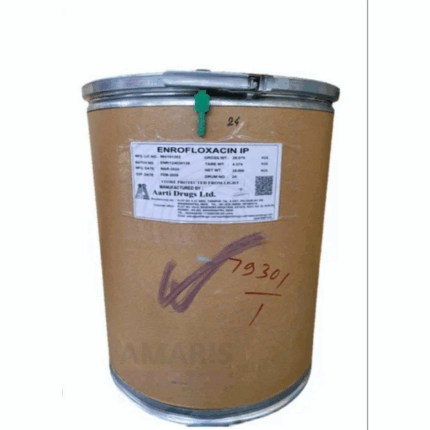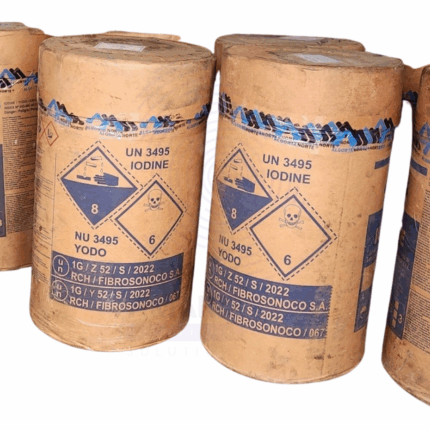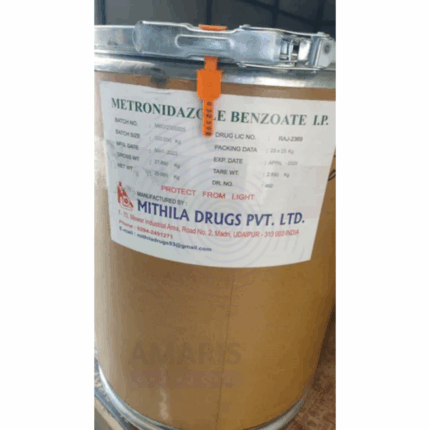Dicyclomine Hydrochloride
Whatsapp Order
Dicyclomine Hydrochloride is an anticholinergic and antispasmodic agent used primarily to relieve smooth muscle spasms in the gastrointestinal tract. It works by blocking muscarinic receptors, thereby reducing muscle contractions and spasms, which helps alleviate symptoms of irritable bowel syndrome (IBS) and other functional bowel disorders. It is commonly available in oral tablets, capsules, and injectable formulations.
Description
Table of Contents
Toggle
Dicyclomine Hydrochloride
Primary Uses
Gastrointestinal Disorders
- Irritable Bowel Syndrome (IBS): Relieves abdominal cramping and pain by relaxing the smooth muscles of the gut.
- Functional Bowel Disorders: Treats spasms in conditions like spastic colon and diverticulitis.
- Gastrointestinal Spasms: Manages spasms associated with colitis, enteritis, and other inflammatory bowel diseases.Preoperative Medication
- Used to reduce secretions and relax smooth muscles before surgery or diagnostic procedures involving the gastrointestinal tract.Treatment of Colic
- Relieves intestinal colic and discomfort in adults and sometimes pediatric patients.
Secondary Uses
Urinary Bladder Disorders
- Sometimes used off-label to relieve bladder spasms in urinary tract dysfunctions.Adjunct Therapy in Gastrointestinal Procedures
- Administered to ease discomfort during endoscopy or radiological imaging by reducing bowel motility.Research Applications
- Utilized in pharmacological studies focusing on muscarinic receptor antagonists and smooth muscle physiology.
PRODUCT KEY FEATURES
- Basic Identification Attributes
- Chemical Name (IUPAC): 2-(Diethylamino)ethyl 1-cyclohexylcyclohexane-1-carboxylate hydrochloride
- Common/Trade Name: Dicyclomine Hydrochloride, Dicycloverine
- CAS Number: 67-92-5
- HS Code: 2924.99.90
- Molecular Formula: C19H35NO2·HCl
- Synonyms:
- Dicycloverine Hydrochloride
- Dicyclomine HCl
- Bentyl (brand name)
- Physical & Chemical Properties
- Physical State: White crystalline powder
- Solubility: Soluble in water and alcohol
- Melting Point: 164–167°C
- Stability: Stable under normal storage conditions
- Safety & Hazard Attributes
- Hazard Class (GHS): Not classified as hazardous; handle as pharmaceutical chemical
- Toxicity: Low acute toxicity, but overdose can cause anticholinergic symptoms
- Exposure Limits: Follow pharmaceutical handling guidelines
- Storage & Handling
- Store in a cool, dry, well-ventilated area away from light
- Shelf Life: Typically 2–3 years under proper conditions
- Regulatory & Compliance
- Approved by FDA and other global regulatory bodies for pharmaceutical use
- Included in various pharmacopeias (BP, USP)
- Environmental & Health Impact
- Low environmental persistence
Not considered ecotoxic or bioaccumulative
SAFETY HANDLING PRECAUTIONS
Safety Handling Precautions
PPE Required:
- Gloves (nitrile or latex)
- Safety goggles
- Lab coat or protective apron
Handling Guidelines:
- Avoid inhalation of powder and dust
- Avoid skin and eye contact
- Use in a well-ventilated area or under fume hood
- Follow GMP and pharmaceutical manufacturing practices
Storage Measures:
- Keep container tightly closed
- Store away from moisture and direct sunlight
- Store in a cool, dry place
Hygiene Practices:
- Wash hands thoroughly after handling
- Do not eat, drink, or smoke while handling product
- Avoid cross-contamination with other chemicals
First Aid Measures
- Inhalation: Move to fresh air; seek medical attention if symptoms persist
- Skin Contact: Wash with soap and water; consult physician if irritation occurs
- Eye Contact: Rinse eyes with plenty of water for at least 15 minutes; seek medical advice
- Ingestion: Rinse mouth with water; seek medical attention if large amounts ingested
Firefighting Measures
- Fire Hazards: Combustible at high temperatures
- Extinguishing Media: Water spray, foam, dry chemical, or CO₂
- Special Precautions: Avoid inhaling smoke and combustion products
Related products
Chlorpheniramine Maleate
Chlorpheniramine Maleate is a first-generation alkylamine antihistamine used primarily to relieve allergy symptoms by blocking H1 histamine receptors. It appears as a white or off-white crystalline powder, freely soluble in water and alcohol. Known for rapid onset and moderate duration of action, it’s widely formulated in pharmaceuticals. It also exhibits mild anticholinergic and sedative effects.
Ellagic Acid
Ellagic Acid is a naturally occurring polyphenolic compound found in numerous fruits, nuts, and vegetables such as pomegranates, strawberries, raspberries, walnuts, and cranberries. It is a potent antioxidant known for its ability to scavenge free radicals and chelate metal ions. Due to its significant anti-inflammatory, anti-carcinogenic, and anti-viral properties, Ellagic Acid has gained extensive interest in pharmaceutical, nutraceutical, cosmetic, and food industries. It appears as a yellow to light brown crystalline powder, insoluble in water but soluble in organic solvents like ethanol and DMSO.
Enrofloxacin Hydrochloride
Enrofloxacin Hydrochloride is a broad-spectrum fluoroquinolone antibiotic used primarily in veterinary medicine. It is the hydrochloride salt of enrofloxacin, offering enhanced solubility and bioavailability. Enrofloxacin inhibits bacterial DNA gyrase and topoisomerase IV, disrupting DNA replication in Gram-negative and Gram-positive organisms as well as some Mycoplasma species. It is available as a white to off-white crystalline powder, used in injectable, oral, and topical formulations designed for livestock, companion animals, and aquatic species.
Iodine Crystals
Iodine Crystals are high-purity elemental iodine in solid crystalline form. These dark violet-black crystals have a characteristic pungent odor and sublime easily at room temperature, releasing violet iodine vapors. Iodine is a halogen element widely used for its antiseptic, oxidizing, and chemical reagent properties in pharmaceutical, industrial, and laboratory applications.
Mebendazole USP ( Micronized white)
Mebendazole USP (Micronized White) is a pharmaceutical-grade anthelmintic agent used for the treatment of parasitic worm infections. The micronized white powder form offers enhanced bioavailability and better dispersion in pharmaceutical formulations. It is effective against a broad spectrum of intestinal parasites including roundworms, whipworms, hookworms, and pinworms. Mebendazole is commonly used in oral tablet and suspension preparations, ensuring efficient parasite eradication with minimal side effects.
Mepyramine Maleate BP
Mepyramine Maleate BP is an antihistamine drug commonly used to relieve allergic symptoms such as hay fever, urticaria, and other allergic reactions. It works by blocking histamine H1 receptors, reducing allergic responses like itching, swelling, and redness. This compound is a white or off-white crystalline powder, soluble in water and alcohol, widely used in pharmaceutical formulations including tablets, creams, and injectables.
Methyl Salicylate BP
Methyl Salicylate BP is a clear, colorless to pale yellow oily liquid with a characteristic strong, sweet, and minty odor. It is an organic ester commonly used for its analgesic, anti-inflammatory, and flavoring properties. Methyl Salicylate is widely used in pharmaceutical preparations, topical pain relief products, cosmetics, and as a fragrance ingredient.
Metronidazole Benzoate BP
Metronidazole Benzoate BP is a benzoate ester derivative of metronidazole, used primarily as an antiprotozoal and antibacterial agent. It is a prodrug that hydrolyzes in the body to release metronidazole, making it more palatable for pediatric and geriatric oral suspensions. It complies with the British Pharmacopoeia (BP) standards for purity and efficacy.


 Preservatives(food)
Preservatives(food) Flavor Enhancers
Flavor Enhancers Acidulants
Acidulants Sweeteners
Sweeteners Antioxidants
Antioxidants Colorants(food)
Colorants(food) Nutraceutical Ingredients (food)
Nutraceutical Ingredients (food) Nutrient Supplements
Nutrient Supplements Emulsifiers
Emulsifiers
 Collectors
Collectors Dust Suppressants
Dust Suppressants Explosives and Blasting Agents
Explosives and Blasting Agents Flocculants and Coagulants
Flocculants and Coagulants Frothers
Frothers Leaching Agents
Leaching Agents pH Modifiers
pH Modifiers Precious Metal Extraction Agents
Precious Metal Extraction Agents
 Antioxidants(plastic)
Antioxidants(plastic) Colorants (Pigments, Dyes)
Colorants (Pigments, Dyes) Fillers and Reinforcements
Fillers and Reinforcements Flame Retardants
Flame Retardants Monomers
Monomers Plasticizers
Plasticizers Polymerization Initiators
Polymerization Initiators Stabilizers (UV, Heat)
Stabilizers (UV, Heat)
 Antifoaming Agents
Antifoaming Agents Chelating Agents
Chelating Agents Coagulants and Flocculants
Coagulants and Flocculants Corrosion Inhibitors
Corrosion Inhibitors Disinfectants and Biocides
Disinfectants and Biocides Oxidizing Agents
Oxidizing Agents pH Adjusters
pH Adjusters Scale Inhibitors( water)
Scale Inhibitors( water)
 Antioxidants(cosmetic)
Antioxidants(cosmetic) Emollients
Emollients Fragrances and Essential Oils
Fragrances and Essential Oils Humectants
Humectants Preservatives
Preservatives Surfactants(cosmetic)
Surfactants(cosmetic) Thickeners
Thickeners UV Filters
UV Filters
 Fertilizers
Fertilizers Soil Conditioners
Soil Conditioners Plant Growth Regulators
Plant Growth Regulators Animal Feed Additives
Animal Feed Additives Biostimulants
Biostimulants Pesticides (Herbicides, Insecticides, Fungicides)
Pesticides (Herbicides, Insecticides, Fungicides)
 Active Pharmaceutical Ingredients (APIs)
Active Pharmaceutical Ingredients (APIs) Excipients
Excipients Solvents(pharmaceutical)
Solvents(pharmaceutical) Antibiotics
Antibiotics Antiseptics and Disinfectants
Antiseptics and Disinfectants Vaccine Adjuvants
Vaccine Adjuvants Nutraceutical Ingredients (pharmaceutical)
Nutraceutical Ingredients (pharmaceutical) Analgesics & Antipyretics
Analgesics & Antipyretics
 Analytical Reagents
Analytical Reagents Solvents(lab)
Solvents(lab) Chromatography Chemicals
Chromatography Chemicals Spectroscopy Reagents
Spectroscopy Reagents microbiology-and-cell-culture-reagents
microbiology-and-cell-culture-reagents Molecular Biology Reagents
Molecular Biology Reagents Biochemical Reagents
Biochemical Reagents Inorganic and Organic Standards
Inorganic and Organic Standards Laboratory Safety Chemicals
Laboratory Safety Chemicals Specialty Laboratory Chemicals(Special Laboratory Equipment)
Specialty Laboratory Chemicals(Special Laboratory Equipment)
 Demulsifiers
Demulsifiers Hydraulic Fracturing Fluids
Hydraulic Fracturing Fluids Scale Inhibitors(oil)
Scale Inhibitors(oil) Surfactants(oil)
Surfactants(oil) Drilling Fluids
Drilling Fluids
 Dyes and Pigments
Dyes and Pigments Bleaching Agents
Bleaching Agents Softening Agents
Softening Agents Finishing Agents
Finishing Agents Antistatic Agents
Antistatic Agents
 Admixtures
Admixtures Waterproofing Agents
Waterproofing Agents Sealants and Adhesives
Sealants and Adhesives Curing Compounds
Curing Compounds Concrete Repair Chemicals
Concrete Repair Chemicals Anti-Corrosion Coatings
Anti-Corrosion Coatings
 Surfactants(cleaning)
Surfactants(cleaning) Builders
Builders Enzymes
Enzymes Solvents (Cleaning)
Solvents (Cleaning) Fragrances
Fragrances
 Electronic Chemicals
Electronic Chemicals Catalysts
Catalysts Lubricants
Lubricants Photographic Chemicals
Photographic Chemicals Refrigerants
Refrigerants Automotive chemicals
Automotive chemicals Pyrotechnic Chemicals
Pyrotechnic Chemicals
 Biodegradable Surfactants
Biodegradable Surfactants Bio-based Solvents
Bio-based Solvents Renewable Polymers
Renewable Polymers Carbon Capture Chemicals
Carbon Capture Chemicals Wastewater Treatment Chemicals
Wastewater Treatment Chemicals
 Pigments
Pigments Solvents(paint)
Solvents(paint) Specialty Coatings
Specialty Coatings Binders/Resins
Binders/Resins Additives
Additives Driers
Driers Anti-Corrosion Agents
Anti-Corrosion Agents Functional Coatings
Functional Coatings Application-Specific Coatings
Application-Specific Coatings
 Fresh Herbs
Fresh Herbs Ground Spices
Ground Spices Whole Spices
Whole Spices Spice Blends
Spice Blends Dried Herbs
Dried Herbs
 Leavening Agents
Leavening Agents Dough Conditioners
Dough Conditioners Flour Treatments
Flour Treatments Fat Replacers
Fat Replacers Decoratives
Decoratives Preservatives(baking)
Preservatives(baking)
 Plasticizers & Softeners
Plasticizers & Softeners Reinforcing Agents
Reinforcing Agents Adhesion Promoters
Adhesion Promoters Vulcanizing Agents
Vulcanizing Agents Antidegradants
Antidegradants Blowing Agents
Blowing Agents Fillers & Extenders
Fillers & Extenders Accelerators & Retarders
Accelerators & Retarders

![Diethanolamine [C4H11NO2 or (CH2CH2OH)2NH] Amaris Chemicals](https://amarischemicalsolutions.com/wp-content/uploads/2025/07/Diethanolamine-C4H11NO2-or-CH2CH2OH2NH-Amaris-Chemicals-430x430.png)






















